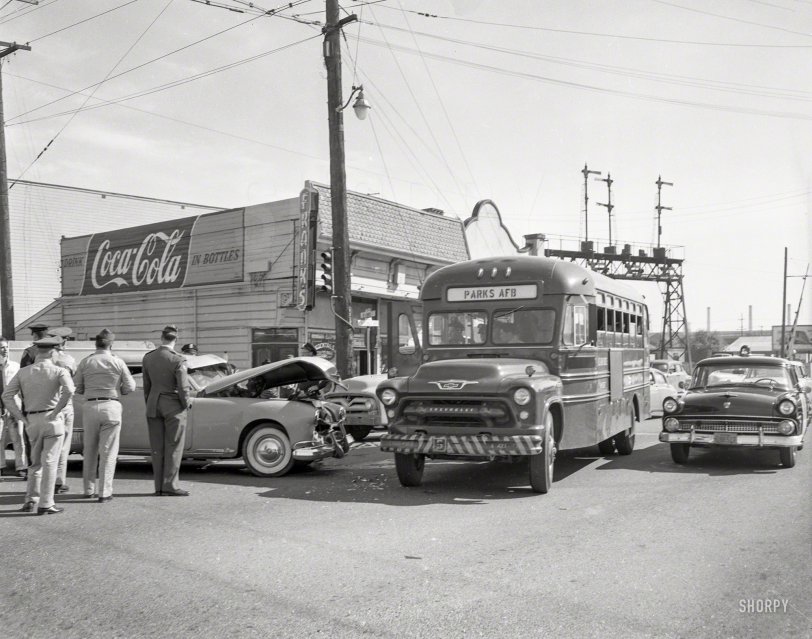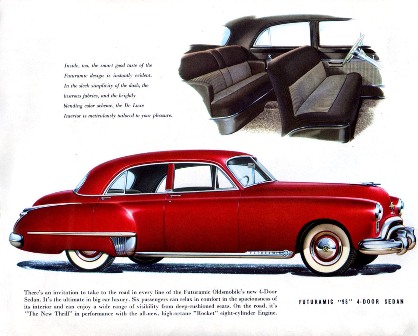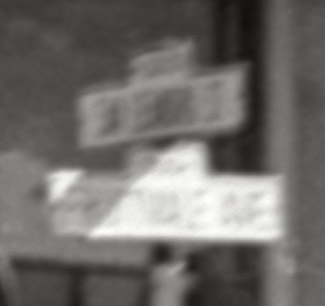


Framed or unframed, desk size to sofa size, printed by us in Arizona and Alabama since 2007. Explore now.
Shorpy is funded by you. Patreon contributors get an ad-free experience.
Learn more.

- Indiana Harbor Belt abides
- Freezing haze
- Corrections (for those who care)
- C&NW at Nelson
- Fallen Flags
- A dangerous job made worse
- Water Stop
- Passenger trains have right of way over freights?
- Coal
- Never ceases to amaze me.
- Still chuggin' (in model form)
- Great shot
- Westerly Breeze
- For the men, a trapeze
- Tickled
- Sense of loneliness ...
- 2 cents
- Charm City
- What an Outrage
- Brighton Park
- Catenary Supports
- Just a Little Before I was Born
- Afternoon normal
- The Flat Iron Cafe survives
- Aging in Place
- Raise your hand
- Good and Bad
- Oh, the 70's
- Nooooooi
- The aluminum tubing
Print Emporium
Cocktails & Cokes: 1957

Oakland or vicinity circa 1957. "Collision with bus." Futuramic Oldsmobile meets military shuttle. And as long as we're at Frank's, how about a Coke? In bottles, of course. 4x5 acetate negative from the News Archive. View full size.
Oldsmobile
It's actually a 1949 Futuramic "98", identified by the ribbed Stainless rock guards on the rear quarter panels, and the "Futuramic" logo on the bottom of the front fender. According to original Oldsmobile factory brochures, the 98's came standard with the "Rocket" V8 engine. And so began the Detroit horsepower wars.

Futuramic details
The Olds is a 1948 98. It was driven by a flathead eight from previous years that Tom McCahill characterized as a "product of the dark ages." (Tom always had a way of getting to the point.) Bodywork was compliments of Art Ross, head of the Oldsmobile design studio at the time.
USAF Uniforms and terminology
I served in the USAF from 1963 to 1972. My reply pertains to that timeframe.
USAF uniforms were specified in AFManual 35-10. The uniforms were classified as formal/semi-formal, class A (the blue suits), class B (casual -- think "Dockers"), and fatigues (I don't remember the "class" on work clothing).
The numbers, 505 and 1505, were derived from the color of the fabric and were a shorthand in referring to the style of the uniform. The fabric was cotton and/or cotton blend -- depending upon where you purchased the uniform. The "1505" was the class B summer uniform during my service. The shirt was short-sleeved with an open collar.
Headgear: the "wheel" shaped cap was the "garrison" cap. It was used chiefly in ceremonial occasions. The smaller, pyramidal cap was the "flight" cap -- better known by a vulgarism that I will leave to the memory of USAF veterans. When wearing fatigues, USAF-style baseball caps were worn.
All uniforms were expected to be kept clean and wrinkle-free. I would wear my 1505s once and then have them laundered with starch. "Military crease", such as those worn by the Marines, were not allowed.
The class B of "casual" uniforms was always undergoing changes with combinations too numerous to mention here.
USAF facilities: runways did not determine the use of "base" in the facility title. Example: Lowry AFB in Denver was a large training base whose runway had been closed for many years.
Other terms used: "Field" as in Hanscom Field outside of Boston (which has a small runway). Another term: "Installation" -- used for small, specialized sites such as remote radar facilities.
AF Uni's
Don't know about 505, but I remember the last day for 1505s, sometime in late 77 or early 78. I was in Tech School in Biloxi MS at the time, and ALL the instructors wore them that day.
As a work Uni, the 1505 was phased out and eventually replaced by the Cotton Green Fatigues which had to be either commercially starched or hand-ironed every damn day. Cotton Fatigues gave way to Rip-Stop Camo Green BDU, same as Army, in approx 1985 as I recall. I retired in 95, Green Camo BDU was still in service.
None of you have mentioned the guys hands in their pockets, a BIG No-No, at least during my time.
May I approach the bench?
I must disagree with sstucky on the identification of the uniforms. I entered the Air Force in 1967 and was issued the short sleeve, cotton, must-be-starched 505 summer uniform. As soon as you moved it began to wrinkle. In 1969 or 70 the 1505 uniform was issued; this is a short sleeve, tropical blend, drycleaned summer uniform. The longsleeve khaki cotton uniforms seen in the photo were similar to those worn by the Army Air Force. In 1947, when the US Air Force was created, khakis continued in the inventory. Khakis were supposed to be starched and they disappeared sometime in the early 1960s. The other guy, obviously, is in blues.
Uniforms
Most of the airmen are wearing the old 1505 cotton khaki uniform which was still in use when I entered active duty in 1973. They were very comfortable but wrinkled badly. They are also wearing the wheel hat which gradually withered away to the point that it was only worn at ceremonies and funerals.
Re: AFBs
The general rule is that if an Air Force facility has a runway, it's a 'base'; if it doesn't, it's a 'station'.
However, lots of Air Force Stations in remote places had runways for supply flights, and Lackland AFB, which is the big USAF basic training base, doesn't have a runway (although it's adjacent to Kelly Field, which does. Lackland was originally part of Kelly, which is probably why it kept the 'base' designation.
Park was also a basic training base, opened during the Korean War and turned over to the Army in 1958. It may be that it was termed a 'base' simply to give it parity with Lackland: bureaucracy is a serious business in the AF.
A Basic Training Facility
Parks was a place like Lackland, where new enlisted recruits learned to march, salute, and make their beds before going off to tech school. It's possible the bus was a shuttle to and from the Oakland Induction Center of Vietnam draft riot fame.
When is an AFB not an AFB?
Parks Air Force Base (AFB) is one of the few AFB's without a runway on site. So AFB in name only!

























On Shorpy:
Today’s Top 5